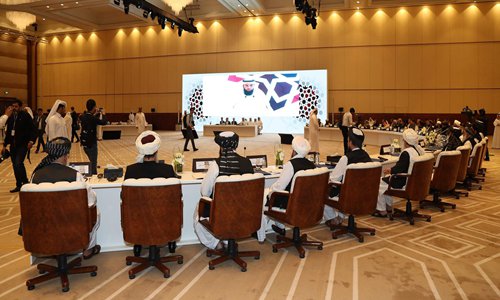HOME >> OPINION
US negotiations with Taliban give rise to peace hopes, but hurdles remain
Source:Global Times Published: 2019/7/8 17:02:52

Photo: VCG
Zalmay Khalilzad, US peace envoy leading talks with the Taliban to end the war in Afghanistan, said on Saturday that the latest discussions were the "most productive session" to date. The two sides will resume their meeting from Tuesday in Qatar.
The seventh round of US-Taliban talks began in late June. Both the Taliban and the US said they have put "serious efforts" and expected an "outcome."
This round of talks involved the withdrawal of foreign troops from Afghanistan, and progress on this issue has reportedly been made. US President Donald Trump has announced several times he plans to withdraw US soldiers from the war-torn regions. This is a general trend of US policy. Washington will retreat from places where it doesn't think it should put in more effort.
The US waged war in Afghanistan, deployed troops there, spent a lot, but gained little. The wars in Iraq and Syria have produced similar results for the US.
The US began to retreat from the Middle East during the tenure of former president George W. Bush. Former president Barack Obama accelerated the pace of withdrawal and then Trump apparently is determined to take US soldiers in Afghanistan, Syria and Iraq back home.
Combating terrorism is perceived to be the main objective of the US in Afghanistan. After Osama bin Laden's death, the US thought it had taken out its main enemy and wanted to retreat from the country. But Washington doesn't want the Taliban to take over again after US troops leave.
The US wants to keep stability in Afghanistan and it also recognizes that the Taliban cannot be easily torn down. Therefore, the US talks with the group so that its interests are not affected during the withdrawal of its soldiers.
Retreating from the war zones is a general strategy of the US - partly by being on its own initiative and partly by being forced by the situation. Obama's rebalancing toward the Asia-Pacific region was aimed at deploying its power in the region to deal with the rise of China. Trump made it clearer by labeling China as a strategic competitor and started all-round competition with China.
In these circumstances, it is natural for the US to dilute its power deployment in other regions.
US policy toward Iran is opposite because the US needs to set an enemy, in this case Iran, so as to maintain its presence and influence in the Middle East and rebuild its alliance to strengthen relations with traditional allies such as Israel.
US Secretary of State Mike Pompeo made an unannounced visit to Afghanistan on June 25 and expressed his hope for "a peace deal before September 1." But it is unlikely that a final deal will be reached as early as that to settle relations between the US and the Taliban. A deal that temporarily mitigates the tensions is more likely.
Given international and regional situations, as well as the political dynamics in Afghanistan changing over the years, even a temporary deal can hardly be made in just one negotiation.
If the Taliban can be turned into a peaceful political force that participates in Afghan politics, it will be significant for the stability of the country and the region. So far, direct talks between the Taliban and the Afghan government, another important stakeholder in the negotiation process, are still on hold.
The peace talks are on the right track. But the process will see more twists and turns.
The article was compiled by Global Times reporter Xu Hailin based on an interview with Li Weijian, a senior research fellow with the Center for West Asian and African Studies, Shanghai Institute for International Studies. xuhailin@globaltimes.com.cn
RELATED ARTICLES:
Posted in: ASIAN REVIEW